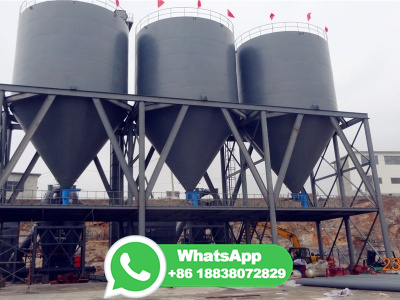
The Bayer process holds an exclusive status for alumina extraction, but a massive amount of caustic "red mud" waste is generated. In this work, three oxalate reagents: potassium hydrogen oxalate (KHC 2 O 4), potassium tetraoxalate (KHC 2 O 4 ·H 2 C 2 O 4), and oxalic acid (H 2 C 2 O 4) were investigated for the Al and Fe extraction process from NIST SRM 600 AustralianDarling range ...
WhatsApp: +86 18203695377
About 76% of the bauxite was refined by the Bayer process for alumina or aluminum hydroxide, and the remainder went to products such as abrasives, cement, chemicals, proppants, and refractories, and as a slag adjuster in steel mills. Alumina production was estimated to be million tons, slightly more than that in 2021.
WhatsApp: +86 18203695377
The invention of the Bayer process by Karl Josef Bayer () from Austria in 1887 was very important for reducing the cost of alumina which was important for industrial production of aluminium. In this process, aluminium compounds of bauxite ore are dissolved in hot sodium oxide solution at 150200 °C.
WhatsApp: +86 18203695377
The Bayer process is the principal industrial means of refining bauxite to produce alumina (aluminium oxide) and was developed by Carl Josef Bayer. Bauxite, the most important ore of aluminium, contains only 3060% aluminium oxide (Al 2 O 3 ), the rest being a mixture of silica, various iron oxides, and titanium dioxide. [1]
WhatsApp: +86 18203695377
Several cases of hazardous events in alumina refineries, including the bauxite residue storage area, introduces some of the process safety issues that have occurred in the past. From there, an introduction to Functional Safety is made representing a systematic approach to deal with this subject in today's alumina refinery design and capacity ...
WhatsApp: +86 18203695377
PDF Format: | 1996 | 1997 | 1998 | 1999 | 2000 | 2001 | 2002 | 2003 | 2004 | 2005 | 2006 | 2007 | 2008 | 2009 | 2010 | 2011 | 2012 | 2013 | 2014 | 2015 | 2016 | 2017 | 2018 | 2019 | 2020 | 2021 | 2022 | 2023 | Appendixes Minerals Yearbook Bauxite and Alumina PDF Format:
WhatsApp: +86 18203695377
Committee for Study of Bauxite, Alumina and Aluminium" [2] in order to share the challenges of the industry and the latest technological and scientific progresses. The scope of the event covers the whole Al production chain, from bauxite refining to aluminium electrolysis, including electrode manufacturing and aluminium smelting processes.
WhatsApp: +86 18203695377![[PDF] BAYER ' S PROCESS FOR ALUMINA PRODUCTION Semantic Scholar](/s0j6hgr/76.jpg)
The Bayer Process (for alumina) as we know it today involves two steps: • The pressure leaching of bauxite with NaOH solution to obtain sodium aluminate solution. • The precipitation of pure aluminum hydroxide from this solution by seeding with fine crystals of Al(OH)3 . The leaching step was invented five years after the precipitation step (Table 1), and the precipitation step was an ...
WhatsApp: +86 18203695377
Process Description 23 Primary aluminum production begins with the mining of bauxite ore, a hydrated oxide of aluminum consisting of 30 to 56 percent alumina (A l2O3) and lesser amounts of iron, silicon, and titanium. The ore is refined into alumina by the Bayer process. The alumina is then shipped to a primary aluminum plant for ...
WhatsApp: +86 18203695377
Manufacturing Process . Aluminum hydroxide is primarily produced through the Bayer process from a reaction of bauxite with a solution of sodium hydroxide. The most common aluminum hydroxide manufacturing process proceeds in steps, the overall equation s for this process are outlined in Figure 1 . Crushed bauxite is dissolved in a sodium hydroxide
WhatsApp: +86 18203695377
Residue of the alumina leaching from bauxite was analyzed for mineral compositions of the mineral ore and its residue for chemical composition, density, and grainsize composition.
WhatsApp: +86 18203695377
Bauxite residue (BR), a byproduct of the industrial production of alumina, has raised environmental concerns in the last decades, due to the presence of high amounts of alkali and various heavy ...
WhatsApp: +86 18203695377
A process flow diagram of the Bayer process is shown in Exhibit 3. The primary purpose of a Bayer plant is to process bauxite to provide pure alumina for the production of aluminum. All bauxite refineries share five common process steps: (1) ore preparation; (2) bauxite digestion; (3) clarification; (4) aluminum hydroxide precipi tation; and (5)
WhatsApp: +86 18203695377
emission alumina trials are being conducted, Australia is leading technologies for the adaptation of brownfield alumina refineries to even lower carbon technologies. 2020 Industry Emissions Aluminium Indirect Alumina Direct Aluminium Direct ex: PFCs Alumina Indirect Bauxite Aluminium PFCs Aluminium Gas Use
WhatsApp: +86 18203695377
tons, 8% more than that reported in 2020, with an estimated value of about 115 million. About 70% of the bauxite was refined by the Bayer process for alumina or aluminum hydroxide, and the remainder went to products such as abrasives, cement, chemicals, proppants, and refractories, and as a slag adjuster in steel mills. Alumina production
WhatsApp: +86 18203695377
The study attempts to: Identify the environmental effects of bauxite, alumina and aluminium production in Brazil; Describe present technical and regulatory measures aimed at dealing with these environmental effects; and Evaluate the effectiveness of these measures.
WhatsApp: +86 18203695377
per tonne of the, the partial digestion of silica from bauxite before converting it into alumina leads to a decrease in precipitation of aluminosilicate and an increase of alumina yield in the Bayer process. This method for Extracting Silica and Alumina from LowGrade Bauxite
WhatsApp: +86 18203695377
2011;43:573590. threats. 2000;50:572578. Recommended publications Use of a Directional Spray System Design to Control Respirable Dust and Face Gas Concentrations Arou... Contribution of liquor...
WhatsApp: +86 18203695377
Depending on the quality of bauxite, the amount of RM generated varies between 55 and 65% of the bauxite processed. Roughly Mg of RM are produced for each Mg of alumina and consequently ...
WhatsApp: +86 18203695377
developed expertise in nonBayer process routes for the production of smeltergrade alumina or for specialist applications such as the production of highpurity alumina. In addition to lowgrade bauxite, other nonbauxitic raw materials may prove to be sources of chemical, special grade, or smeltergrade alumina, including: • Clay • Nepheline
WhatsApp: +86 18203695377
The bauxite ore must first be refined into alumina (aluminum oxide) before it can be electrolyzed into aluminum ingot. According to a recent survey by the International Aluminium Institute (IAI), the production of one metric ton of alumina requires approximately metric tons of bauxite (taking into account the purity of bauxite and losses during
WhatsApp: +86 18203695377
Stage 2: Alumina production. In the 1890s, Austrian chemist Carl Josef Bayer invented a revolutionary process for extracting alumina from bauxite. Today—over 100 years later—some 90% of ...
WhatsApp: +86 18203695377
Process Description 23 Primary aluminum production begins with the mining of bauxite ore, a hydrated oxide of aluminum consisting of 30 to 56 percent alumina (A l2O3) and lesser amounts of iron, silicon, and titanium. The ore is refined into alumina by the Bayer process. The alumina is then shipped to a primary aluminum plant for ...
WhatsApp: +86 18203695377
alumina clusters in a refinery will be shown as an example. Keywords: Alumina refinery; alumina classification; twin hydrocyclones; annular dist. ributor. 1. Introduction. Alumina is usually produced from bauxite in the wellestablished Bayer process. This process utilizes the thermodynamic properties of the caustic sodaaluminum hydroxide ...
WhatsApp: +86 18203695377
The Bayer Process was patented in 1888 in Germany by the Austrian chemist, Karl Joseph Bayer [].The simple chemistry of the process is that the hydrated forms of aluminum in bauxite, readily dissolve in heated caustic (NaOH) solutions (the DIGESTION step, see Chap. 4).The advantage is that nearly all of the minerals in bauxite containing other metallic ions do not dissolve and so can be ...
WhatsApp: +86 18203695377
ISBN Foreword This book is designed as an introductory text to the extraction of alumina, the feedstock for aluminium production, from bauxite ore. The audience is high school students and teachers, university undergraduates and people starting work in the alumina/aluminium industry.
WhatsApp: +86 18203695377